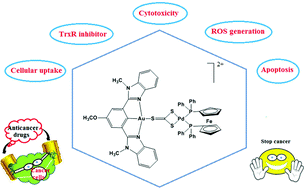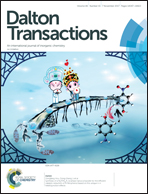The cytotoxicity and mechanism of action of new multinuclear Scaffold AuIII, PdII pincer complexes containing a bis(diphenylphosphino) ferrocene/non-ferrocene ligand†
Abstract
New multinuclear gold(III), palladium(II) pincer complexes containing bis(diphenylphosphino) ferrocene/non-ferrocene ligands of formula [(L)Au(μ2–η2-CS3)Pd(dppf)](PF6)2, 1, and [(L)Au(μ2–η2-CS3)Pd(dppe)](PF6)2, 2 (HL = 5-methoxy-1,3-bis (1-methyl-1H-benzo[d]imidazol-2-yl)benzene, dppf = 1,1′-bis(diphenylphosphino)ferrocene, and dppe = bis(diphenylphosphino)ethane) have been synthesized and fully characterized. Both complexes are more cytotoxic to a number of human cancer cell lines than cisplatin. Moreover, complex 1 is more active than auranofin as the reference gold compound against a panel of several human tumor cell lines. Chemosensitivity tests completed on cisplatin sensitive and resistant cell lines have confirmed that both complexes were able to overcome cisplatin resistance. The complexes successfully inhibited the enzymes thioredoxin reductase (TrxR) and glutathione reductase (GR). The cellular uptake of both gold and palladium of the complexes was studied, which indicated a high biological stability of the complexes. The complexes 1 and 2 increase the production of ROS in HCT-15 cells. In addition, these complexes induce major levels of cancer cell death by apoptosis.



 Please wait while we load your content...
Please wait while we load your content...